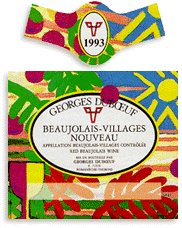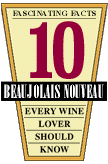 At the annual Lalinde wine fair last weekend, 9-10 August, there was once again a vast choice for the wine lover. Wine growers from all over France come to set their ines out on tables, the lush plane trees of the square next to the canal bassin forming a dappled green umbrella and providing shade from the beautiful hot weather we have been enjoying.
At the annual Lalinde wine fair last weekend, 9-10 August, there was once again a vast choice for the wine lover. Wine growers from all over France come to set their ines out on tables, the lush plane trees of the square next to the canal bassin forming a dappled green umbrella and providing shade from the beautiful hot weather we have been enjoying.My special pleasure is always seeking out the most charming of wine-making couples, M. et Mme Roger Duroux from the Thibeaud Maillet Chateau near St Emilion. Their Pomerol must be one of the most delicious -- no need to go spend a small ransom on a Petrus or a La Tour -- the Chateau Thibeaud has a long tradition of being constant and reliable as an excellent Pomerol.

Chateau Thibeaud Maillet is one of the "Vignerons Independants d'Aquitaine", a Pomerol vineyard close to St Emilion in the Libournais.
The chateau Thibeaud-Maillet truly deserves mention as its quality/price balance is most interesting to the wine conoisseur. In fact, a Pomerol of this excellent quality still obtainable at under €30, is something one should rather keep a well-guarded secret! "Robe grenat profond , ce vin a de l'allure et à peine débouché son arôme titille agréablement les narines de l'oenologue averti!"
The aroma of red fruits but without the acidity, a hint of spices such as cinnamon, it has a fullness on the tongue but stays light. There is no after-taste of tannin as one often finds in some of the great Medoc wines, but it retains the elegant nextar quality of the best of the St Emilion wines.
The Pomeral region consists of about 700 hectares of Pomeral vineyards and on each corner a chateau, of which Thibeaud Maillet is one.
Founded at the beginning of the 19th century by the Thibeaud family, the estate has been successfully run by the family in the small vinyard tradition of always offering only the best that their 2 hectares can produce. The estate sits on a plateau with a slight eastern slant and the soil is characterised by its sandy gravelly texture, ideal for a very good maturing of the grape.
But more important almost than any of this are the people who produce the wines: the Duroux couple is the epitomy of elegance and charm, knowledgeable and enthusiastic about their wines and always ready to engage in a fascinating discussion about any subject that you may wish to raise.
Treat yourself and go visit their chateau -- not only will you meet the most delightfl people, but they will also show you around their family estate and let you taste their superb wines!
The Chateau Thibeaud-Maillet estate is open to the public, by appointment from Monday to Saturday, 09h00 to 20h00 and on Sunday from 11h00 to 18h00.
English and German is spoken. Wines are for sale directly to the public.
CHATEAU THIBEAUD MAILLET
33500 - POMEROL
Tél : 05 57 51 82 68
Fax : 05 57 51 58 43
E-mail : oga.richardot@orange.fr
According to the Cellar Notes site, Pomerol is the smallest of the great appellations in Bordeaux. Red wines make up almost all the production. Merlot is the dominant grape in Pomerol (as it is in St. Emilion) and the wines from this area often contain 80% or more of that variety.
The Pomerol wine can be more robust than others in Bordeaux. They have an exclusive velvety quality. Pomerol is at its very best when the bottle reaches the age of 15 -- so do not be in a hurry to open that bottle!
Cépage : 85 % merlot ; 15% cabernet franc
The Merlot variety produces wines in Pomerol that are soft, full of fruit and rich in flavor. Even though the Merlot grape produces wonderful wines in this Pomerol, the real reason that it is grown here is that frosts arrive earlier in this region than in the Medoc. Merlot ripens earlier than Cabernet Sauvignon and is much more likely to produce a mature crop. The second, most used grape in Pomerol is Cabernet Franc. Pomerol estates tend to be much smaller than their counterparts in the Medoc region. There are only about 1800 acres of vineyards in Pomerol.
These vineyards are spread among the roughly 150 estates that produce an average of 1000 to 4000 cases each. In the Medoc region, the estates are generally much larger with production in the 10,000 to 20,000 case range for most of the estates. There has never been an official classification of the chateaux of Pomerol. Even without an official classification, there are several properties that have distinguished themselves based on the consistent quality they have achieved over many years.
The soils of Pomerol range from a gravel and clay mixture found in the eastern part of the commune to a lighter soil with more sand in the west. The Plateau of Pomerol is a gravel deposit on the east side of Pomerol where most of the famous and well known chateaux are located. Within this gravel deposit you will find clay in quantities that range from a mixture with the gravel to actual pockets of almost pure clay. The most famous chateau of Pomerol is Chateau Petrus. Petrus is located on one of the pockets of clay on the plateau. The wines from the plateau are fuller, richer and generally better than those from the sandy area to the west.

Another site The Winedancer adds a bit more information:
History
Pomerol's history goes back a long way. The plateau was crossed by two Roman road's, one of which was used by the poet Ausonius to go to his villa, Lucaniac. In the 12th century, the hospitallers of Saint John of Jerusalem established their first commandery in the Libourne as well as a hospice, or special stopping place for pelgrims on their way to Santiago de Compostela. The vineyards were distroyed during the Hundred Years' War, replanted in the 15th and 16th centuries, and have been famous for quality ever since the latter half of the 19th century.
Soil
Soil in Pomerol is a unique, outstanding geological phenomenon. The topsoil is made up of gravel that varies in compactness, with layers of clay and sand. The subsoil includes iron oxide, locally called "crasse de fer". This soil, combined with a special micro-climate, accounts for Pomerol's absolutely inimitable personality.
Vineyards
Though it is tiny, Pomerol is famous world over. The vineyards are located 30 kms north-east of Bordeaux and 3 kms from the city of Libourne on a slightly rolling plateau, that slopes gradually towards the Isle river valley and its confluence with the Dordogne. It is bordered by Barbanne stream to the north, Saint Emilion to the east, and Libourne to the south and east. This is one of the tiniest vineyards in
 Bordeaux: 4 kms long and 3 kms wide, 780 hectares of vines that produce an average of 28,000 hectolitres, or the equivalent of 4 million bottles of wine a year. Merlot accounts for 80% of vines planted, withthe remainder devided between Bouchet or Cabernet Franc (15%) and Cabernet Sauvignon (5%). These vines attain perfection in such a special soil.
Bordeaux: 4 kms long and 3 kms wide, 780 hectares of vines that produce an average of 28,000 hectolitres, or the equivalent of 4 million bottles of wine a year. Merlot accounts for 80% of vines planted, withthe remainder devided between Bouchet or Cabernet Franc (15%) and Cabernet Sauvignon (5%). These vines attain perfection in such a special soil.Quality
Pomerol wine is true work of art, owing to be happy blend of the mild Aquitaine climate, privileged location, and local winemaking know-how. There are a great number of wine chateaux, and many winegrowers cultivate quite a small area (sometimes less than one hectare) with as much love and care as the owners of prestigious growths whose names are known all over the world. Patience, determination, hard work and science have given Pomerol its reputation as one of the finest wines in the world. The excellent homogeneous quality means that Pomerol has no official classification, which helps to maintain good relations and cooperation between producers.
Pomerol's charm is immediate, and appeals as much to the most demanding connoisseur as to the person just learning to enjoy wine. Fine colour, power and an elegant bouquet combine to produce velvety wines with subtle aromas of berries, violets and truffles. Pomerol wines are deeply coloured and admirably structured, with remarkable elegance and a taste that is both rich and generous. Pomerol is even delicious young, though it reaches perfection after 5-10 years in bottle, depending on the chateau and wine storage conditions.
How to appreciate
As with all great wines, there are a few basic guidelines: handle the bottle with care and bring it up to room temperature (16-18 C) over a 24 hour period. Do not hesitate to decant the wine. either to seperate it from the sediment that is always present in old wines, or let a young wine breathe and develop its bouquet. Pomerol is an ideal accompaniment to almost any food, and is particulary fine with red meat, game and cheese.
Apart from Chateau Thibeaud Maillet, here are a few of the Pomeral greats:
Chateau Petrus
Vieux-Chateau-Certan
Chateau Petit-Village
La Tour a Pomerol
Chateau Trotanoy
Certan-de-May
Chateau La Conseillante
Le Pin
Chateau Lafleur
Cateau Lafleur-Petrus
Chateau Gazin
Chateau l'Evangile
Clos L'Eglise
Chateau Plince

So, to sum up -- this is what you need to impress when next you are at a diner table:
Pomerol wine information:
Appellation: Appellation Pomerol Controlée
no ranking in Pomerol!
Location: Along the Isle river
Places: Pomerol, Libourne, etc
Soil: Very diverse from gravels to clay (in Pétrus)
Size: 800 ha
less than 2,000 acres
Production: 5.3 million bottles
Strictly reserved to red wine
Grapes: Merlot, Cabernet Franc, Cabernet Sauvignon and Malbec
Type of wine: Full-body red wine
Strong bouquet
Age: More than 10 years and up to 20 years
15 years is the optimum for a Pomerol
Vintages:
(recommended) 2005, 2003, 2000, 1998, 1995, 1990, 1989
Aromas: Well-ripen red fruits, Licorice, Dried fruits
Pomerol Wine and Food:
Game
Partridge
Veal
Roasted turkey
Pears in wine
Pomerol Wine and Cheese:
Cantal, Comté, Maroilles, Ossau-Iraty. Saint-Nectaire, Langres

Click on Link:
Chateau Lalinde : The perfect venue for your event




















